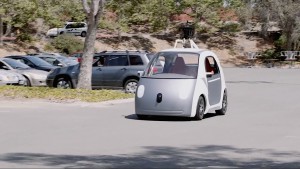Nissan, Mercedes-Benz, Tesla, possibly even Apple. The list of manufacturers planning to launch autonomous vehicles over the coming decade is rapidly growing.
Automakers insist the new technology will keep you safer than ever on the nation’s roads. But it could make you sicker. Carsick, that is. A new report from the University of Michigan Transportation Research Institute, or UMTRI, warns that as much as 12% of the U.S. population may experience motion sickness while riding in autonomous vehicles.
“Motion sickness is expected to be more of an issue in self-driving vehicles than in conventional vehicles,” writes UMTRI researchers Michael Sivak and Brandon Schoettle. They blame three factors, notably the fact that, “By switching from driver to passenger, by definition, one gives up control over the direction of motion, and there are no remedies for this.”
Anywhere from 6% to 12% of U.S. adults might experience some degree of carsickness “at some time,” in a self-driving vehicle, the report suggests, some suffering extreme bouts quite frequently.
Motion sickness is usually caused by a conflict between what the eyes see and what the body feels, usually through the inner ear which is responsible for balance control. But it also can be triggered by the sense that one is no longer in control of the body’s movements, or because a vehicle passenger can’t predict which way they’re going to move next. Adults typically are more susceptible to motion sickness than children, UMTRI notes.
(Delphi shows automated vehicle capabilities with SF to NY trek. Click Here for the story.)
How to address the problem? The report says travelers susceptible to the problem might try closing their eyes or even sleeping. And, if necessary, they might try commonly available medications. Some travelers also have had success with bands that tap into pressure points on the wrist.
The good news, the report also indicates, is that autonomous vehicles could be programmed to deliver a smoother ride than a conventional vehicle with a human behind the wheel, a step likely also to reduce motion sickness.
The issue of motion sickness is one of the many problems – some of them until now unforeseen – that have cropped up as research progresses on autonomous vehicle technology.
Nissan CEO Carlos Ghosn last week reiterated the automaker’s pledge to put its first fully autonomous vehicle on the road in 2020 – and said Nissan will work up to that in stages, with a partially self-driving vehicle to come in 2016, with a more advanced version to follow a year later.
(Automakers race to outdo each other with new, low-cost anti-collision technology. Click Here for more.)
One recent study suggested that within two decades at least 80% of the vehicles sold worldwide will have at least some level of autonomous capabilities.
Earlier this week, Morgan Stanley’s automotive analyst Adam Jonas also suggested this “autopia” will soon become the norm, rather than the exception, forecasting a time when America’s roads well see, “roving fleets of completely autonomous vehicles in operation 24 hours/day, available on your smartphone.”
Indeed, the CEO of carsharing service Uber has indicated that he hopes to switch to fully driverless vehicles as that technology becomes available. That might take longer than just getting autonomous vehicles on the road, with human drivers ready to take control, if needed, cautioned Nissan’s Ghosn.
But now, these autopian drivers will have to consider problems beyond the technical, like how to keep their passengers from getting carsick.
(Drone delivery? US car shoppers look to the future. For more, Click Here.)


Many current auto drivers close their eyes while driving so this will be natural for those folks…
BTW, I’d like to hope that commuters will be safer with autonomous vehicles but I would not count on it unless these cars have redundant mechanical and electronic operating systems like aircraft, extremely competent software/hardware programming and security plus a lot more than what is currently being discussed for these vehicles.
Probably no more carsick than passengers in a car today.
Maybe it was the sight of the Googlemobile that made people sick…??